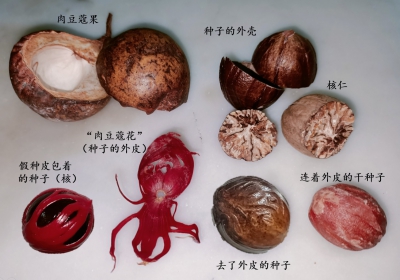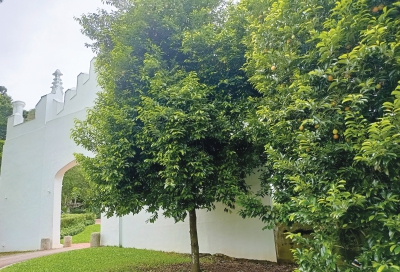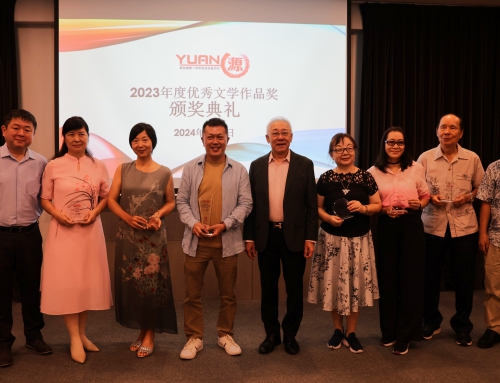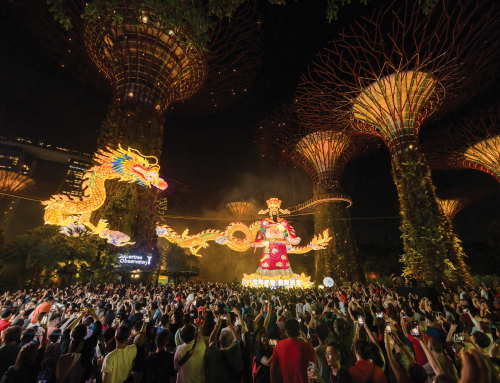豆蔻的故事
文图 · 刘家明
槟城,又名槟榔屿。去槟城游玩,本来是想听一些有关槟榔的故事。不想在市中心,导游却叫我们去“打卡”全马来西亚最大的豆蔻(雕像)!后来由于行程有变,机缘巧合下带我们去参观槟岛西部,浮罗山背南天门前的“义合豆蔻厂”。这才知道,原来槟城著名的除了槟榔就是豆蔻了。
历史中的豆蔻

肉豆蔻果的各个有用部分
豆蔻作为中药和香料,早就记录在中国的许多药典里,不过种类繁多。从学名来说,俗称的豆蔻有指白豆蔻或草果,红豆蔻则是大高良姜的果实。草豆蔻是Alpinia,香豆蔻是Amomun。而我们一路来叫的Nutmeg,规范的俗名是“肉豆蔻”。为了适应本地的俗称,本文就把肉豆蔻简称为豆蔻。
豆蔻和丁香是历史上香料战争的主角,从几百年前开始,它们就几乎与黄金同值。豆蔻有药用功能,可以防腐,是高级食材的配料,也是香料,整个豆蔻果可以说是物尽其用。把豆蔻果剥开,拿出果核(种子),果肉去水晒干烘干就可当做香料使用,去皮后加工去其涩味可做成零食;豆蔻种子外壳有清晰的纹路,还有一层鲜红色的假种皮包着,红色的假种皮俗称“豆蔻花”,也最值钱;打破了种子壳可以看到有美丽花纹的核仁。整个豆蔻果依其各部分的特性,可以制成不同的产品,如祛风药油、药膏、茶粉、食品等。十六七世纪的西方富豪甚至把豆蔻核仁带在身上,用餐时就把它拿出来磨粉食用炫富。
豆蔻与新加坡的渊源
-400x279.jpg)
威廉·法夸尔收藏的豆蔻图(图源:国家博物馆)
在中世纪以前,豆蔻市场被阿拉伯商人垄断,出产地被高度保密。随后西方航海大国葡萄牙发现了产豆蔻和丁香的香料群岛(东印度摩鹿哥群岛),跟着是西班牙,接着是荷兰东印度公司加入战团,最后是十九世纪的英国和法国殖民团队的到达。除了大国间的争斗,更是残暴的殖民掠夺,涂炭生灵,把香料群岛变成原住民的炼狱。当时英国人还把豆蔻带到各地种植,其中格林纳达岛最为成功。
英国殖民槟城后也在当地试种,开始了在东南亚种植豆蔻的历史。1819年莱佛士登陆新加坡后,时任驻扎官威廉·法夸尔也在福康宁山试种这种昂贵的经济作物。法夸尔对自然科学有兴趣,早年在马六甲当官的时候就已聘请了画工把豆蔻画了下来。在彩色摄影还没有发明之前,这是最漂亮完备的豆蔻图,原作现在收藏在国家博物馆。
豆蔻树种植实验在新加坡非常成功,激发了大批商人投资豆蔻园。其成功与获利比其他农作物如咖啡、甘蔗、茶叶和棉花等大得多,在1830年后更是达到高峰期。本地的报章在1827年还有专业人士撰文教人种豆蔻,据悉只要7个劳工,50头牲口和2套耕犁车,就可以维持一个1000棵树的豆蔻园,经济效益非常高。
可惜好景不长,1840年一种来历不明的“溃疡病真菌”开始在豆蔻园传开,患病的树都结不出果,全新加坡的豆蔻园无一幸免。到了1850年,全岛几乎已经没有健康的豆蔻树了。早入行的豆蔻园主得以全身而退,留下了不少破产的投机园主。豆蔻树从此走入历史。
福康宁山的豆蔻树

福康宁公园香料园里的豆蔻树
莱佛士曾于1822年在皇家山(现在的福康宁山)开辟了一个试验香料园,命人种了125棵豆蔻树和播下了1000粒豆蔻种子,还有450棵丁香树以及其他经济作物。随着农业在本地快速的消失,香料园早已荒废。
近年来园林局重新规划和整理了福康宁公园,在山坡上种满了在建国历史里曾经出现过的香料,把香料园还原,也让我们可以近距离观赏到雌雄果同株的豆蔻树。雌豆蔻果较小,单核,底部只有一横纹。雄果较大,内有双核,底部有十字纹。只有雌果能繁衍,传宗接代。
豆蔻路和乌节路
乌节路的Orchard有果园的意思,其实更贴切的是豆蔻园。1830年时,几乎所有的豆蔻园都集中在这里。虽然富豪园主们后来改行了,不过很多的物业资产仍然留在这里。大家比较熟悉的欧思礼、布拾连、卡佩芝、史各士,经禧区的卡涅尔都是豆蔻园主。其他的地方如安详山、达士顿、如切和汤申也有一些豆蔻园。
城市重建,街道易名。19世纪时盛极一时的豆蔻园区,目前只在ION大厦的侧面留下了一个大大的豆蔻雕像,以及在幸运商业中心的后面,留下一条短窄的豆蔻路,以纪念短短的香料时代的辉煌。
(作者为本地电子工程师)
The Story Of Nutmeg
Author: Low Kah Meng
Penang, is also known as Pulau Pinang, is where we visitors expect to know some stories about Areca catechu. However, unexpectedly, in the city, our tour guide took us to “check in” at the largest nutmeg statue in all of Malaysia! Later, due to a change in the itinerary and a fortunate turn of events, we ended up visiting the Ghee Hup Nutmeg Factory located in the western part of Penang Island, near the South Heavenly Gate on the back of Mount Pulau Pinang. It was then we discovered that besides Areca catechu, Penang Island was famous for nutmeg, too!
The History of Nutmeg
Nutmeg has been recorded in many Chinese pharmacopoeias as a traditional medicine and spice, but there are various types. Scientifically speaking, the common name, cardamom, can refer to either white nutmeg or red nutmeg, while “red nutmeg” is the fruit of the greater galangal. Grass cardamom is called the Alpinia, while fragrant nutmeg is the Amomum. And what we have been commonly calling “nutmeg” is more precisely referred to as “Myristica fragrans”. To align with the local terms, this article simply refers to it as “nutmeg”.
Nutmeg and cloves have been the leading figures in the spice war throughout history. For the past few centuries, they have been as valuable as gold. Nutmeg serves multiple purposes: possessing medicinal properties, becoming a preservative or an ingredient of gourmet cuisine, and serving as a spice. Every part of the nutmeg fruit can be used to its fullest extent. When you peel the nutmeg fruit and extract the seed, the fruit pulp can be dried and used as a spice. After peeling the fruit and processing it to eliminate its astringent flavor, it becomes a snack. The outer shell of the nutmeg seed shows distinctive patterns, with a layer of bright red aril, known as “nutmeg flowers”, which is the most valuable. Breaking the seed shell reveals a beautifully patterned kernel. Depending on the properties of each part, the nutmeg fruit can be made into different products, such as medicated oil, ointment, tea powder, and various food items. In the 16th and 17th centuries, wealthy and powerful Westerners even carried nutmeg kernels with them, bringing them out during meals to freshly grind and consume them to show off their wealth.
Nutmeg’s Connection with Singapore
Prior to the Middle Ages, the nutmeg market was monopolized by Arab traders, and the origins were kept as highly confidential. Later, major Western marine powers became involved in the trade. Portugal was the first to discover the Spice Islands where nutmeg and cloves were produced, known today as the Moluccas in the East Indies, followed by Spain. And then the Dutch East India Company joined the competition. In the 19th century, British and French colonial teams arrived.
Beyond the struggles among these major powers, this period was marked by ruthless colonial exploitation, inflicting great suffering on the indigenous people, and turning the Spice Islands into a living hell. During this period, the British also brought nutmeg to various regions for cultivation, with Grenada Island being the most successful.
After the British colonization of Penang, the British also tried local nutmeg cultivation, starting the history of nutmeg planting in Southeast Asia. In 1819, after Sir Stamford Raffles landed in Singapore, William Farquhar, who was then the Resident of Singapore, conducted planting experiments with this expensive cash crop on Fort Canning Hill. Farquhar had a keen interest in natural sciences and had previously hired an artist to have nutmeg painted when he served as an official in Malacca. Before the invention of color photography, the painting was the most detailed and exquisite drawing of nutmeg. The original artwork is currently kept in the National Museum.
The nutmeg tree planting experiments in Singapore were highly successful, which spurred a significant increase to the investment in nutmeg plantations. Its success and profitability far surpassed those of other crops like coffee, sugarcane, tea, and cotton, reaching its peak after 1830. In 1827, local newspapers even featured an article by professionals, teaching people how to plant nutmeg. It was reported that maintaining a nutmeg plantation with 1,000 trees required only seven laborers, 50 animals, and two sets of plowing equipment, indicating high yields of economic returns.
Unfortunately, this prosperous time was short-lived. An unidentified “canker fungus” began spreading in nutmeg plantations, stopping the affected trees from bearing fruits. Not a single nutmeg plantation in Singapore was spared. By 1850, there were barely any healthy nutmeg trees left on the entire island. Early nutmeg plantation owners managed to get out without any loss, but many speculative plantation owners went bankrupt. Nutmeg cultivation has thus faded into history.
Fort Canning’s Nutmeg Tree
In 1822, Sir Stamford Raffles opened an experimental spice garden on Government Hill, now known as Fort Canning Hill. He ordered 125 nutmeg trees planted and 1000 nutmeg seeds sowed, along with 450 clove trees and various other cash crops. As agriculture rapidly disappeared in the locality, the spice garden was left abandoned.
In recent years, the National Park Board has undertaken a revitalization project for Fort Canning Park. They have planted a variety of spices that were once a part of the nation’s founding history, bringing back the spice garden. This allows visitors to closely observe both male and female nutmeg fruits in the same tree. The female nutmeg fruit is smaller, with a single seed and a single horizontal stripe at the bottom, while the male fruit is larger, containing two seeds and a cross-shaped pattern. Only the female fruit can reproduce and carry on the family legacy.
Nutmeg Road and Orchard Road
Orchard in “Orchard Road” signifies a garden of fruits, but it would be more suitable to call it Nutmeg Garden since almost all nutmeg plantations were concentrated in this area in 1830. Although wealthy plantation owners later diversified their interests, many property assets remained there. Familiar names such as Oxley, Prinsep, Cuppage, Royal Plaza Cairnhill owned nutmeg plantations in the area. Other locations like Mount Faber, Dawson, Rochor and Tanglin also have nutmeg plantations.
With urban redevelopment, street names were changed. The once-thriving Nutmeg Garden of the 19th century is now reduced to only one large nutmeg statue on the side of ION Orchard and a narrow Nutmeg Road behind Lucky Plaza, commemorating the brief but glorious spice era.
(Translated by Jason Low Hui Yee, Cho Yew Yee, Heng Cho Fai from Maris Stella High School, Winning entry of the Chinese-English Translation Competition)
-600x291.jpg)
乌节路和豆蔻路 (图源:谷歌地图绘制)






